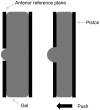Clinical application of accommodating intraocular lens
- PMID: 29977819
- PMCID: PMC6010372
- DOI: 10.18240/ijo.2018.06.22
Clinical application of accommodating intraocular lens
Abstract
The present review describes recent advances in application of accommodating intraocular lenses (AIOLs). Standard monofocal intraocular lenses (MIOLs) only correct distance vision, while AIOLs are designed to allow both good distance vision and near vision, which is achieved through the contraction and relaxation of ciliary muscles by providing transformation of the axial movement or curvature of the lens. Thus, AIOLs may be a better choice for those patients who demand a higher level of visual performance. Since techniques to analyze the performance of AIOLs have not been standardized, and there is a variety of both subjective and objective methods, it is hard to measure the performance of these intraocular lenses. By evaluating advantages and disadvantages of various AIOLs, and introducing techniques for measurement the performance postoperative, this paper can provide some relative information on choosing the type of AIOLs in the clinic.
Keywords: accommodating intraocular lenses; amplitude of accommodation.
Figures






Similar articles
-
Accommodating intraocular lenses: a critical review of present and future concepts.Graefes Arch Clin Exp Ophthalmol. 2007 Apr;245(4):473-89. doi: 10.1007/s00417-006-0391-6. Epub 2006 Aug 30. Graefes Arch Clin Exp Ophthalmol. 2007. PMID: 16944188 Review.
-
Accommodating intraocular lenses: a review of design concepts, usage and assessment methods.Clin Exp Optom. 2010 Nov;93(6):441-52. doi: 10.1111/j.1444-0938.2010.00532.x. Clin Exp Optom. 2010. PMID: 21182659 Review.
-
Anterior Segment Biometry of the Accommodating Intraocular Lens and its Relationship With the Amplitude of Accommodation.Eye Contact Lens. 2017 Mar;43(2):123-129. doi: 10.1097/ICL.0000000000000248. Eye Contact Lens. 2017. PMID: 26974533
-
Comparison of near vision, intraocular lens movement, and depth of focus with accommodating and monofocal intraocular lenses.J Cataract Refract Surg. 2013 Dec;39(12):1872-8. doi: 10.1016/j.jcrs.2013.05.049. J Cataract Refract Surg. 2013. PMID: 24427795 Clinical Trial.
-
Visual outcomes after accommodating intraocular lens implantation.J Cataract Refract Surg. 2006 Apr;32(4):628-33. doi: 10.1016/j.jcrs.2006.01.027. J Cataract Refract Surg. 2006. PMID: 16698485 Clinical Trial.
Cited by
-
New insights in presbyopia: impact of correction strategies.BMJ Open Ophthalmol. 2023 Jan;8(1):e001122. doi: 10.1136/bmjophth-2022-001122. BMJ Open Ophthalmol. 2023. PMID: 37278419 Free PMC article. Review.
-
Safety, biocompatibility, and potential functionality of a new accommodative intraocular lens: An experimental study in rabbits.Heliyon. 2023 Sep 1;9(9):e19604. doi: 10.1016/j.heliyon.2023.e19604. eCollection 2023 Sep. Heliyon. 2023. PMID: 37810139 Free PMC article.
-
The effects of premium intraocular lenses on presbyopia treatments.Adv Ophthalmol Pract Res. 2022 Feb 23;2(1):100042. doi: 10.1016/j.aopr.2022.100042. eCollection 2022 May-Jun. Adv Ophthalmol Pract Res. 2022. PMID: 37846220 Free PMC article. Review.
-
Presbyopia - A Review of Current Treatment Options and Emerging Therapies.Clin Ophthalmol. 2021 May 24;15:2167-2178. doi: 10.2147/OPTH.S259011. eCollection 2021. Clin Ophthalmol. 2021. PMID: 34079215 Free PMC article. Review.
-
Presbyopia Treatments by Mechanism of Action: A New Classification System Based on a Review of the Literature.Clin Ophthalmol. 2021 Sep 6;15:3733-3745. doi: 10.2147/OPTH.S318065. eCollection 2021. Clin Ophthalmol. 2021. PMID: 34522079 Free PMC article. Review.
References
Publication types
LinkOut - more resources
Full Text Sources
Other Literature Sources
